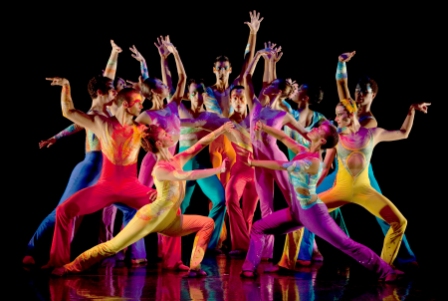Courtesy of trustatrts.org
Combining the crafted and refined art of European ballet with the passion and rhythm of Latin music, Ballet Hispanico delivered an emotional performance last Friday at the Williams Center for the Arts.
The emotion came through four organized sets of dances, each telling the story of melancholic Catalonians praying for rain on a barren land, modern civilizations coping with the unavoidable pull of fate, expressing individuality, and celebrating multiculturalism. Four movements were used to reflect this change in the diversity of Latino culture.
Jardí Tancat, evoked melancholy as six dancers gracefully moved around the stage in a semi-tribal manner, making no extraneous movements or noise as they prayed for rain. The dance was choreographed to a collection of Catalonian folk songs performed by Maria del Mar Bonet. Jardí Tancat translates to “Closed Grounds” in Catalan, which refers to the nature of the farmland during the drought brought to life by this piece.
Another movement, Sortijas, told the story about how fate pulls on our strings daily and how we have become so vulnerable to its tenacious grasp. One dancer, who played fate, kept interfering with another dancer’s routine, which represented the life of the everyday individual. This climactic fight for independence from fate was relatable to every audience member. The dance gave fate the upper hand in the battle of wills.
Sortijas’s choreography symbolized this inevitable failure of liberation. The mysterious and foreboding nature of the scene put one on edge, as the supernatural conflict became more tangible for the viewer.
Discarding the message, the dancers’ technique was still notable.
“The performance was breathtaking to say the least. With agility and graceful poise, dancers transformed the medium-sized theatre into the grandest concert hall. From the flying sweat with every flick of their heads, to the resounding vibrato with every stomp of their feet, it was truly a performance to remember,” Torera Fagbenle ‘17 said.
Sombrerísimo, a dance that has been described as a “work-in-progress,” utilized the force of six men to represent passion and individuality within a group. Their coordination and grace in action was extraordinary. Contorted bodies flawlessly landed flips and made the routine look so easy. The varied nature of the routine proved to be an extraordinarily difficult piece to master, as the tempo changed erratically and without warning. Sombrerísimo was a great feat achieved.
Danzón, Ballet Hispanico’s final dance, took command of the audience’s attention with its riveting musical score and choreography. The entire company performed what has been called the official dance of Cuba, an evolution of Haitian contra dance. Danzón has taken traditional Caribbean dance and transformed it into a joyous celebration of music and movement. Over the course of three parts, the dancers energetically moved to make a traditionally rigid structure into a free-flowing art form. Danzón topped off a solid and exciting night.
“Ballet Hispanico was vibrant, sizzling and ‘un baile llamativo’” Yanel Garcia ‘16 said.




































































































